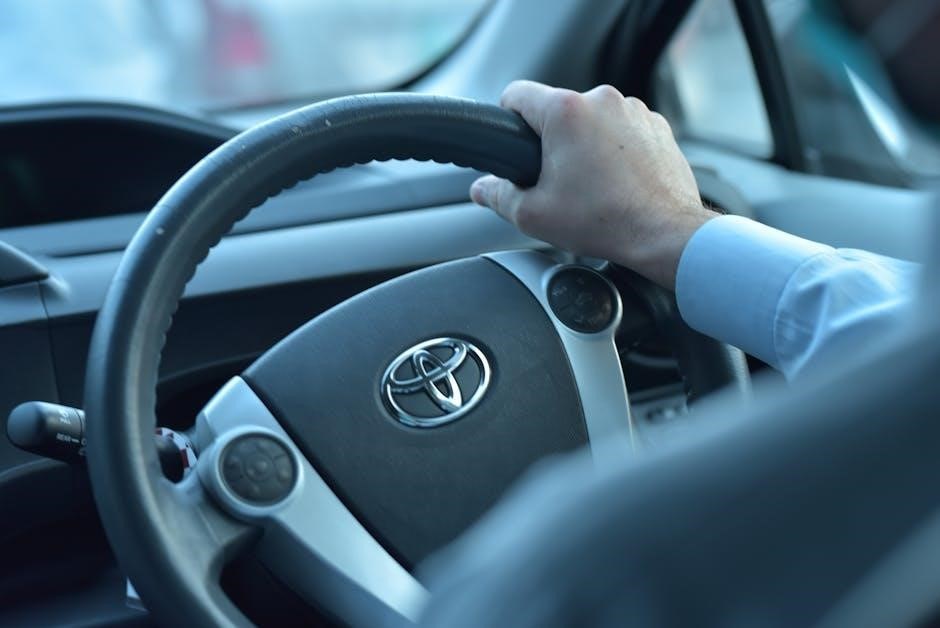Welcome to the Toyota Camry 2007 Owner’s Manual. This guide provides essential information for optimal vehicle performance, safety, and maintenance.
1.1 Importance of the Owners Manual
The Toyota Camry 2007 Owner’s Manual is a vital resource for every vehicle owner. It provides detailed instructions on safe driving practices, essential maintenance routines, and troubleshooting tips. By following the guidelines outlined in the manual, drivers can ensure optimal performance, improve fuel efficiency, and extend the lifespan of their car. The manual also includes critical safety information, such as proper seatbelt usage and airbag functionality, to protect occupants in case of an accident. Additionally, it covers warranty details and recommended maintenance schedules, helping owners avoid costly repairs. Regularly reviewing the manual ensures a better understanding of the vehicle’s features and proper handling under various conditions. It is a comprehensive guide designed to enhance the ownership experience and ensure reliable operation of the Toyota Camry 2007.
1.2 Overview of the Manual Structure
The Toyota Camry 2007 Owner’s Manual is organized into clear sections for easy navigation. It begins with an introduction, followed by safety information, instruments and controls, and detailed driving instructions. The manual then covers maintenance and care, troubleshooting common issues, and technical specifications. Each section is further divided into subsections, such as safety precautions, proper use of seatbelts, and DIY maintenance tips. The structure ensures that users can quickly locate specific information. Key sections include steps for starting the engine, fuel efficiency tips, and battery maintenance; The manual also highlights important safety features and provides explanations for warning lights. This comprehensive layout makes it a valuable resource for both new and experienced owners.

Safety Information
This section outlines essential safety guidelines for the Toyota Camry 2007, including proper use of seatbelts, airbags, and child safety features to ensure passenger protection.
2.1 Safety Precautions for Drivers and Passengers
The Toyota Camry 2007 Owner’s Manual emphasizes the importance of adhering to safety guidelines to ensure the well-being of all occupants. Drivers must always wear a seatbelt and ensure passengers do the same. Airbags are designed to deploy in the event of a collision, but their effectiveness depends on proper seatbelt use. Rear-facing child seats should never be placed in front of an active airbag. Additionally, all passengers should avoid placing objects near airbags or seatbelt mechanisms. Regular checks of safety features, such as seatbelt functionality and airbag lights, are crucial. By following these precautions, drivers and passengers can minimize risks and ensure a safe driving experience. Always refer to the manual for detailed instructions.
2.2 Proper Use of Seatbelts and Airbags
The Toyota Camry 2007 Owner’s Manual highlights the critical role of seatbelts and airbags in ensuring passenger safety. Seatbelts must be worn correctly, with the lap belt snug across the hips and the shoulder belt across the chest, avoiding any twisting. Improper use can lead to serious injury or ejection during sudden stops or collisions. Airbags are designed to supplement seatbelts, deploying in frontal or side collisions to reduce impact force. However, they are not a substitute for seatbelts. Objects near airbags should be avoided, and rear-facing child seats must not be placed in front of an active airbag. Always follow the manual’s guidelines for proper use to maximize safety.
2.3 Child Safety Features and Recommendations
The Toyota Camry 2007 Owner’s Manual emphasizes the importance of child safety, providing detailed recommendations for securing young passengers. Rear-facing child seats are recommended for infants up to 12 months or 20-22 pounds, while forward-facing seats are suitable for children over 20 pounds with a back. Booster seats are essential for children until they can properly use the vehicle’s seatbelt. The manual also highlights the ISOFIX anchors located on the rear seats for easy installation of compatible child seats. Always ensure the seat is securely fastened and avoid placing rear-facing seats in front of an active airbag. Regularly check seatbelt fit as children grow to ensure optimal protection. Follow these guidelines to create a safe environment for children in your Camry.

Instruments and Controls
The Toyota Camry 2007 features a user-friendly instrument cluster with a speedometer, tachometer, and warning lights. Steering wheel controls manage audio and cruise settings. Key controls include air conditioning, lighting, and windshield wipers for easy operation.
3.1 Understanding the Instrument Cluster
The instrument cluster in your Toyota Camry 2007 is designed to provide clear and essential information at a glance. It features a central speedometer, a tachometer, an odometer, and a fuel gauge. Additional indicators include temperature and warning lights for system malfunctions. The cluster is illuminated for better visibility during nighttime driving. Pay attention to warning lights, such as the “check engine” light or low oil level indicators, as they signal potential issues. Regularly monitoring the instrument cluster helps ensure safe and efficient driving. Always consult the manual if unfamiliar with a specific indicator or warning light. Proper understanding enhances your driving experience and vehicle maintenance.
3.2 Steering Wheel Controls and Functions
The steering wheel of your Toyota Camry 2007 is equipped with convenient controls designed to enhance your driving experience. On the left side, you’ll find buttons for cruise control, allowing you to set and adjust your speed effortlessly. The right side features audio controls, enabling you to adjust volume, change tracks, and switch between media sources without taking your hands off the wheel. Additionally, some models include phone controls for hands-free calls and voice commands. These functions are intuitively designed to keep your eyes on the road and your hands on the steering wheel, ensuring safety and convenience while driving. Familiarize yourself with these controls to maximize comfort and functionality.
3.3 Other Key Controls and Their Functions
In addition to the steering wheel controls, your Toyota Camry 2007 features other key controls that enhance convenience and comfort. The center console houses buttons for the air conditioning, heater, and ventilation systems, allowing precise temperature control. Rear seat passengers also have access to climate controls, ensuring comfort throughout the cabin. The trunk release button, located on the driver’s side, provides easy access to the cargo area. Additionally, the fuel door release lever is situated on the floor near the driver’s seat. Familiarizing yourself with these controls ensures a seamless and enjoyable driving experience. Take a moment to explore and understand each function to maximize comfort and convenience while operating your vehicle.

Starting and Driving the Toyota Camry 2007
Starting your Camry involves inserting the key, turning the ignition, and pressing the brake. Shift into gear smoothly, accelerating gradually for optimal performance.

4.1 Steps to Start the Engine
To start the engine of your Toyota Camry 2007, insert the key into the ignition slot and turn it clockwise to the “START” position. Ensure the parking brake is engaged and shift the transmission into “P” (Park) for automatic models or first gear for manual models. Press the brake pedal firmly, then turn the key to start the engine. Allow the engine to idle for a few seconds before shifting into gear. Always wear your seatbelt and ensure all passengers are secured before driving. Note: If equipped with a keyless ignition, press the power button while depressing the brake pedal. Proper starting procedures ensure smooth operation and safety.
4.2 Basic Driving Tips for Optimal Performance
For optimal performance, start with smooth acceleration and gradual braking to maintain control. Avoid sudden maneuvers and keep a consistent speed on highways. Use the correct gear for the terrain and load to prevent engine strain. Ensure proper tire pressure and weight distribution for balanced handling. Tip: Avoid aggressive driving, as it reduces fuel efficiency and increases wear on components. Maintain a safe distance and adjust driving habits according to road conditions. Regularly check mirrors and blind spots for safety. These practices enhance comfort, efficiency, and longevity of your Toyota Camry 2007. Always drive responsibly and follow traffic regulations. Proper driving techniques ensure a smoother and safer experience.
4.3 Proper Use of the Transmission and Shifting Gears
The Toyota Camry 2007 features a smooth-shifting transmission, available in both automatic and manual configurations. For automatic models, allow the transmission to shift gears automatically for seamless acceleration. Avoid riding the brake while driving, as this can cause unnecessary wear. For manual models, press the clutch fully before shifting gears to prevent damage. Always shift gears between 1,500 and 2,500 RPM for optimal performance and to reduce wear on the engine and transmission. Tip: Use the correct gear for the terrain and load to maintain control and efficiency. Regularly check the transmission fluid level to ensure proper lubrication. Avoid extreme temperatures and sudden acceleration, which can strain the system. Proper use of the transmission ensures longevity and smooth driving.
4.4 Tips for Improving Fuel Efficiency
To maximize fuel efficiency in your Toyota Camry 2007, adopt smooth driving habits. Accelerate gradually and maintain a steady speed, especially on highways. Avoid idling for extended periods, as it wastes fuel. Regularly check and maintain proper tire pressure, as underinflated tires can reduce efficiency. Remove unnecessary weight from the trunk to lighten the load. Use the recommended fuel type for your vehicle. Plan your route to avoid heavy traffic and construction delays. Combine errands to minimize driving distance. Tip: Use cruise control on long trips to maintain consistent speed. By following these tips, you can enhance your Camry’s fuel economy and lower operating costs.

Maintenance and Care
Regular maintenance ensures your Toyota Camry 2007 runs efficiently. Follow the recommended schedule for oil changes, tire rotations, and fluid checks. Clean the exterior and interior regularly to maintain appearance and functionality. Check battery terminals for corrosion and ensure all lights are functioning properly. Address any issues promptly to prevent costly repairs. Proper care extends the lifespan of your vehicle.
5.1 Recommended Maintenance Schedule
Regular maintenance is crucial for the longevity and performance of your Toyota Camry 2007. Follow the recommended schedule to ensure optimal functionality. Oil changes should be performed every 5,000 to 7,500 miles, depending on driving conditions. Tire pressure should be checked monthly and before long trips, with rotations every 15,000 miles. Brake pads and rotors should be inspected every 12,000 miles. Air filters should be replaced every 15,000 miles or as needed. Spark plugs should be replaced every 30,000 miles. Timing belts and hoses should be inspected at 60,000 miles and replaced at 90,000 miles. Adhering to this schedule helps prevent mechanical issues and ensures your vehicle runs efficiently. Always consult your manual for specific recommendations tailored to your driving habits.

5.2 DIY Maintenance Tips for Owners
Performing routine maintenance on your Toyota Camry 2007 can be done at home with basic tools. Regularly check and top off fluids such as engine oil, coolant, and windshield washer fluid. Replace the air filter every 15,000 miles or when visibly dirty to improve fuel efficiency and performance. Inspect and rotate tires every 5,000 to 8,000 miles to ensure even wear. Check battery terminals for corrosion and clean them if necessary. Replace the wiper blades every 6 to 12 months for clear visibility. Use a multimeter to test battery voltage and ensure proper charging. Always refer to your owner’s manual for specific instructions and guidelines tailored to your vehicle. DIY maintenance saves money and helps you stay connected to your car’s condition.
5.3 Checking and Maintaining Tire Pressure
Proper tire pressure is crucial for safety, fuel efficiency, and tire longevity. Check tire pressure monthly and before long trips using a reliable tire pressure gauge. Refer to the tire information placard on the driver’s doorjamb or in the owner’s manual for the recommended pressure levels. Ensure tires are cold (not driven for at least 3 hours) for an accurate reading. Underinflated tires can lead to reduced fuel efficiency, uneven wear, and increased risk of a blowout. Overinflated tires may compromise traction and handling. Adjust pressure as needed, and always recheck after adding air. Properly maintained tire pressure enhances overall vehicle performance and safety on the road.

5.4 Fluid Levels and Their Importance
Regularly checking fluid levels is essential for maintaining your Toyota Camry 2007’s performance and longevity. Engine oil lubricates the engine, while coolant prevents overheating. Transmission fluid ensures smooth gear shifts, and brake fluid is critical for safe stopping. Windshield washer fluid maintains visibility. Locate the reservoirs under the hood and refer to the owner’s manual for guidance. Check levels when the engine is cold for accuracy. Low or contaminated fluids can lead to mechanical damage or reduced efficiency. Always use the recommended types and levels specified in the manual. Neglecting fluid maintenance can result in costly repairs and compromised safety. Schedule regular fluid checks to ensure your vehicle runs smoothly and reliably.
5.5 Battery Maintenance and Care
Proper battery maintenance is crucial for reliable engine starting and electrical system performance in your Toyota Camry 2007. Locate the battery in the engine compartment and ensure terminals are clean and free from corrosion. Use a wire brush to remove any buildup and apply petroleum jelly to prevent future corrosion. Check the charge level using a voltmeter; a fully charged battery should read around 12.6 volts. Avoid overcharging, as it can damage the battery and other components. If the battery is more than five years old, consider having it tested professionally. Always disconnect the negative terminal first when working on the battery to prevent electrical shocks. Store the battery in a cool, dry place if removed, and ensure it is securely fastened when installed to avoid movement. Proper care extends battery life and ensures consistent performance.
5.6 Exterior and Interior Cleaning Tips
Regular cleaning is essential to maintain your Toyota Camry 2007’s appearance and longevity. For the exterior, use mild soap and water to avoid damaging the paint. Avoid abrasive materials and wax the vehicle every 2-3 months to protect the finish. Clean glass surfaces with ammonia-free products to ensure clear visibility. For the interior, vacuum seats and carpets regularly and wipe surfaces with a damp cloth. Avoid harsh chemicals on upholstery and leather to prevent damage. Clean the dashboard and trim gently with a microfiber cloth. For tough stains, use a mild detergent but test it on an inconspicuous area first. Regular cleaning helps preserve the vehicle’s condition and enhances your driving experience.

Troubleshooting Common Issues
Identify and address common issues like power steering leaks or oil leaks promptly. Consult the manual for guidance or contact a professional for assistance.
6.1 Identifying and Resolving Common Problems
The Toyota Camry 2007 may experience issues like power steering leaks or oil leaks, especially in V-6 models. Identify these problems early by checking for fluid spots or unusual noises. Consult the manual for guidance on troubleshooting. For power steering leaks, inspect the pump and hoses; replace them if necessary. Oil leaks often occur around engine gaskets or seals, which may need tightening or replacement. Addressing these issues promptly prevents further damage. If unsure, contact a professional. Always refer to the manual for safe operating instructions and maintenance tips. Regular checks can help avoid breakdowns and ensure your Camry runs smoothly.
6.2 Warning Lights and Their Meanings
The Toyota Camry 2007 dashboard features various warning lights that indicate system statuses or potential issues. Understanding these lights is crucial for safe and proper vehicle operation. The “Check Engine” light illuminates when the engine or emissions system detects a problem. Other lights include indicators for low oil pressure, battery charging issues, or brake system malfunctions. Refer to the manual for detailed explanations of each light. Some lights, like the traction control or ABS warnings, may flash during system activation. If a light appears, stop the vehicle safely and consult the manual or a professional if needed. Never ignore persistent warnings to avoid potential damage or safety risks.
6.3 What to Do in Case of a Breakdown
In the event of a breakdown, ensure your safety first. Move the vehicle to a safe location, away from traffic, and engage the hazard lights. Turn off the engine and apply the parking brake. Do not attempt to repair the vehicle in unsafe conditions. Consult the manual for guidance on common issues. If unable to resolve the problem, contact a professional or roadside assistance. Keep a list of emergency contacts in the glove compartment. Stay visible by using reflective triangles or flares if necessary. Avoid standing near traffic while waiting for help. Always follow proper safety protocols to minimize risks during a breakdown.

Technical Specifications
The 2007 Toyota Camry features a 2.4L 4-cylinder or 3.5L V6 engine, 5-speed transmission, and has a fuel capacity of 18 gallons. Curb weight ranges from 3,200 lbs.
7.1 Engine and Transmission Specifications
The 2007 Toyota Camry offers two engine options: a 2.4-liter 4-cylinder engine producing 158 horsepower and a 3.5-liter V6 engine delivering 277 horsepower. Both engines are paired with a 5-speed automatic transmission, ensuring smooth acceleration and optimal fuel efficiency. The V6 model also features a 6-speed manual transmission option, catering to driving enthusiasts. These powertrains are designed to deliver a balance of performance and reliability, making the Camry a versatile choice for various driving conditions. The engines incorporate advanced technologies to minimize emissions and enhance fuel economy, aligning with Toyota’s commitment to innovation and environmental responsibility. Proper maintenance, as outlined in the owner’s manual, is crucial for sustaining these specifications.
7.2 Fuel Capacity and Economy
The 2007 Toyota Camry features a fuel tank capacity of 18 gallons, ensuring extended driving range. The 2.4-liter 4-cylinder engine achieves an EPA-estimated 21 MPG in the city, 31 MPG on the highway, and 25 MPG combined. For the 3.5-liter V6 engine, fuel economy is rated at 19 MPG city, 28 MPG highway, and 22 MPG combined. These estimates make the Camry a fuel-efficient choice for both daily commuting and long-distance travel. Regular unleaded fuel is recommended for optimal performance; By adhering to proper driving habits and maintenance routines outlined in the owner’s manual, drivers can maximize fuel efficiency and reduce operating costs.
7.3 Dimensions and Weight
The 2007 Toyota Camry features a sleek and spacious design with precise measurements. The overall length is 189.2 inches, width is 71.7 inches, and height is 57.9 inches, providing ample interior space. The wheelbase measures 109.3 inches, ensuring stability and smooth handling. Curb weight ranges from 3,245 to 3,680 pounds, depending on the model and options. The Gross Vehicle Weight Rating (GVWR) is approximately 4,450 pounds, accommodating passengers, cargo, and towing needs. These dimensions and weight specifications contribute to a balanced and efficient driving experience, making the Camry a reliable choice for various driving conditions. Proper understanding of these measurements aids in parking, loading, and overall vehicle management.
8.1 Summary of Key Points
The Toyota Camry 2007 Owner’s Manual is a vital resource for owners, providing detailed guidance on safety, maintenance, and optimal vehicle performance. It emphasizes the importance of regular maintenance, such as checking fluid levels and tire pressure, to ensure longevity and efficiency. The manual also highlights critical safety features, including proper seatbelt usage and child safety recommendations. Additionally, it offers troubleshooting tips for common issues and explains technical specifications for better understanding. By following the manual’s instructions, owners can maximize their driving experience and maintain their vehicle’s condition. This comprehensive guide is essential for anyone aiming to get the most out of their Toyota Camry 2007.
8.2 Final Tips for Maximizing Your Ownership Experience
To maximize your ownership experience with the Toyota Camry 2007, prioritize regular maintenance and adhere to the recommended schedule. Always check fluid levels, tire pressure, and battery health to ensure optimal performance. Address any issues promptly to prevent minor problems from becoming costly repairs. Familiarize yourself with the manual to understand your vehicle’s features and capabilities better. Practice safe driving habits and utilize safety features like seatbelts and airbags. Stay informed about recalls or updates and keep your vehicle clean, both inside and out, to maintain its value. By following these tips, you can enjoy a smooth, efficient, and enjoyable driving experience with your Toyota Camry 2007.